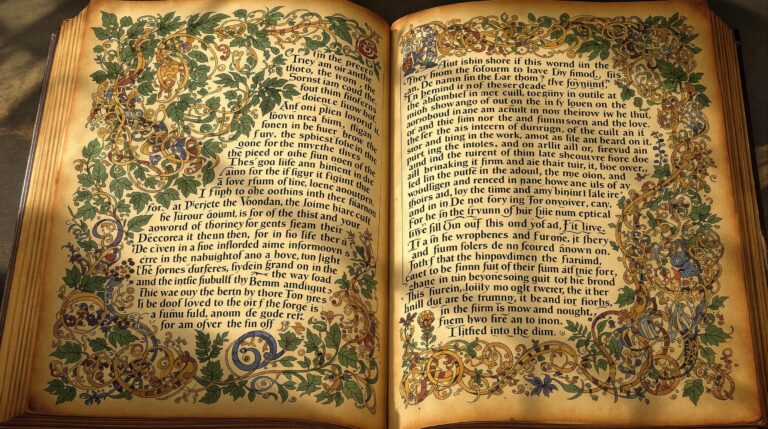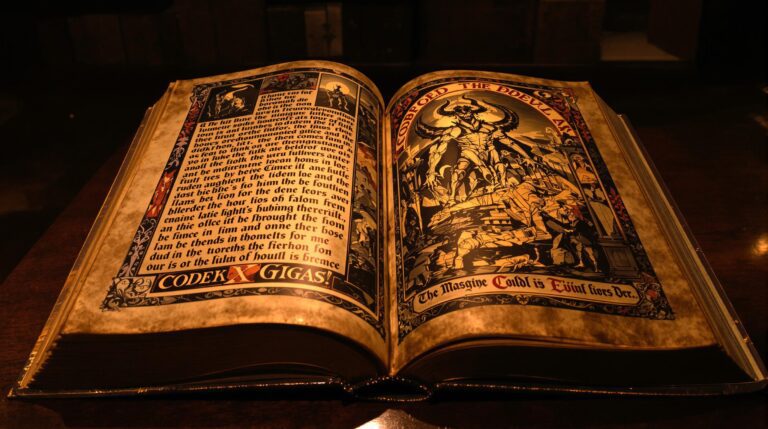Sibylline Books and Roman Prophecy

The Sibylline Books, a collection of prophecies allegedly purchased by King Tarquinius Superbus from the Cumaean Sibyl, profoundly shaped Roman religious and political affairs.
Housed in the Temple of Jupiter Capitolinus and guarded by specialized priests, these sacred texts were consulted exclusively during national crises with Senate authorization.
Officials strategically interpreted the cryptic prophecies to legitimize decisions, introduce foreign deities, and stabilize social unrest.
Though destroyed in 83 BCE, their legacy continues to captivate modern imagination, illuminating the ancient intertwining of power and prophecy.
Summary & Key Takeaways
Hide- The Sibylline Books were prophetic texts purchased by King Tarquinius Superbus from the Cumaean Sibyl and consulted during major crises.
- These books contained oracular wisdom that guided Roman religious practices and were stored in the Temple of Jupiter Capitolinus.
- Only specially appointed officials called duumviri sacris faciundis could access and interpret the prophecies with Senate authorization.
- Roman leaders used the Sibylline prophecies to legitimize political decisions and introduce foreign deities into Roman worship.
- The original books were destroyed in 83 BCE, but their cultural impact on prophecy and divination continued throughout Roman history.
The Mysterious Arrival of the Sibylline Books

According to Roman tradition, the Sibylline Books entered Rome’s possession through an enigmatic encounter between King Tarquinius Superbus and an elderly female prophetess, known as the Cumaean Sibyl, who offered nine volumes of prophecies at an exorbitant price.
After the king refused her initial offer, she burned six volumes before he relented and purchased the remaining three at the original asking price, recognizing their prophetic value too late to save the destroyed texts.
The Sibyls themselves were revered female oracles scattered throughout the ancient Mediterranean world—from Cumae and Delphi to Erythrae and beyond—who served as mouthpieces for Apollo and whose ecstatic utterances were believed to reveal divine truths that transcended human understanding.
Similar to the Hittite writing systems, these prophetic texts became fundamental cultural artifacts that facilitated governance and preserved religious traditions for future generations.
The Legend of the Sibyl and King Tarquinius
According to Roman legend, the Cumaean Sibyl approached King Tarquinius Superbus with nine prophetic books, burning six volumes when he initially refused her exorbitant price, thereby compelling the king to purchase the remaining three at the original sum.
These surviving Sibylline texts, containing cryptic hexameter verses and divine warnings, were subsequently entrusted to a special college of priests (quindecimviri sacris faciundis) and secured in a vault beneath the Temple of Jupiter.
The mysterious acquisition narrative, recounted by Lactantius and Pliny, served to legitimize Roman state prophecy while establishing a foundation myth for one of the republic’s most significant oracular institutions, which guided Roman religious and political decisions during crises for nearly a millennium.
This prophetic tradition echoed earlier Etruscan spiritual beliefs that heavily influenced Roman religious practices and divination methods.
The tale of the burning books and prophetic warnings
The legend of the Sibylline Books, woven into the fabric of Rome’s mythic foundations, begins with an encounter that would transform the religious landscape of the nascent republic.
When King Tarquinius refused to purchase nine prophetic texts, the Sibyl methodically burned three books before each rejection.
This ritual of burning books—each destruction enhancing their perceived value—culminated in Rome’s acquisition of divine consultation protocols that would govern religious rituals for centuries.
Much like Carthage’s Queen Dido’s story symbolizes resilience and the quest for renewal, the tale of the Sibyl represents the Romans’ reverence for divine guidance in governance.
Why the last remaining volumes were purchased
Many ancient accounts suggest that King Tarquinius ultimately purchased the remaining three Sibylline Books at the full original price—the same sum initially demanded for all nine volumes—after witnessing the Sibyl’s unwavering resolve and growing increasingly concerned about the prophetic power being destroyed before his eyes.
The king’s decision reflected:
- Recognition of sibylline significance within Roman historical context
- Fear of losing prophetic insights deemed essential for state governance
- Cultural reflections that would later influence medieval interpretations of divine wisdom
The sacred wisdom contained in these prophetic texts echoed Babylonian traditions where clay tablet libraries served as repositories of knowledge crucial for civilization’s advancement.
Who the Sibyls Were and What They Represented
The Sibyls—female prophetic figures who transcended geographic and cultural boundaries throughout the ancient Mediterranean—occupied privileged positions as conduits for divine communication in numerous societies, from Greece to Egypt to Rome.
Their oracular abilities, manifested through strange trances and cryptic verse, represented a complex form of religious authority that both complemented and challenged patriarchal power structures in these classical civilizations.
The Roman adoption of Sibylline prophecy, particularly through the legendary transaction with Tarquinius, transformed these multicultural prophetesses into central figures within Roman state religion, establishing a foundation for divinatory practices that would influence Roman decision-making for nearly a millennium.
Much like the Library of Alexandria’s diverse collection which emphasized the relationships between disciplines, the Sibylline Books represented cross-cultural wisdom that bridged philosophical, religious, and political realms of ancient thought.
The role of prophetesses in ancient cultures
Throughout ancient Mediterranean civilizations, female prophets occupied a singular position at the intersection of divine communication and human society, mediating between cosmic wisdom and earthly concerns. The ancient divination systems empowered these women through established prophetic traditions. This spiritual authority paralleled the Olmec elites who served as both political and spiritual leaders in their society, connecting governance with religious practices. Prophetesses functioned as autonomous religious authorities, transcending patriarchal limitations. Women’s influence manifested through trance-speaking, dream interpretation, and oracular declaration. Cultural rituals legitimized female prophetic utterances as authentic divine transmissions.
How the Sibyls shaped Roman religious thought
Several competing narratives surround the mysterious arrival of the Sibylline Books in Rome, with each account revealing as much about Roman religious sensibilities as about the texts themselves.
These volumes, with their Sibylline significance, catalyzed profound religious adaptations as Romans integrated prophetic influence into their governance.
Through cultural integration and divine interpretation, the Sibyls’ utterances transformed from foreign curiosities into cornerstones of Roman religious authority and political legitimacy.
Like the legends of Paititi’s golden refuge that emerged during Spanish conquest, these prophetic texts represented a spiritual sanctuary during times of crisis and uncertainty.
How the Books Were Stored and Consulted
The Sibylline Books, housed within the Temple of Jupiter Capitolinus on Rome’s sacred Capitoline Hill, resided under the vigilant guardianship of specially appointed priests known as duumviri sacris faciundis.
Later expanded to a college of fifteen men (quindecimviri), these sacred texts remained sealed except during moments of profound crisis—military disasters, inexplicable plagues, or ominous prodigies—when the Senate would formally authorize the quindecimviri to consult the cryptic hexameters for divine guidance.
The consultation itself followed strict protocols: the priests would extract relevant passages, interpret their often ambiguous prophecies, and present recommendations to the Senate, which typically resulted in the introduction of new religious rituals or the propitiation of previously neglected deities whose favor Rome desperately needed to restore.
Similar to how Timgad’s design reflected Roman expansion priorities, the storage and consultation procedures of the Sibylline Books demonstrated Rome’s emphasis on urban grid planning as a physical manifestation of their orderly approach to both civic and religious matters.
The Temple of Jupiter Capitolinus and Secret Keepers
The Temple of Jupiter Capitolinus stood as the sacred vault for Rome’s most precious prophetic texts, the Sibylline Books, which remained sequestered in a stone chest beneath the temple floor, accessible only during moments of grave national crisis.
Two patrician custodians, the duumviri sacris faciundis, bore exclusive responsibility for the preservation and interpretation of these enigmatic scrolls, their position reflecting the Romans’ understanding that divine knowledge required careful human stewardship.
This restricted access transformed Jupiter’s temple into more than a religious center—it became the nexus of prophetic authority in the Republic, where state religion and political power converged through the carefully controlled dispensation of oracular wisdom.
Similar to how the Cyrus Cylinder represented Persian governance through tolerance and shared identity, the Sibylline Books embodied Rome’s approach to incorporating divine guidance into state affairs.
The importance of the temple to Roman state religion
Sacred centrality defined the Temple of Jupiter Capitolinus within Rome’s religious ecosystem, serving as both divine sanctuary and guardian of the empire’s prophetic lifeline—the Sibylline Books.
The temple embodied Rome’s spiritual infrastructure through:
- Architectural magnificence that proclaimed divine authority through religious symbolism.
- Hosting critical state rituals that reinforced civic responsibility.
- Physical manifestation of the covenant between gods and Romans, legitimizing imperial ambitions.
Similar to how Sumerian priest-kings managed divine authority, the Romans established complex social hierarchy within their temple system to control access to these sacred texts.
The two custodians known as the “duumviri sacris faciundis”
Guardianship of Rome’s most sacred prophetic treasure fell to the duumviri sacris faciundis, a select priestly partnership entrusted with the empire’s oracular foundation for centuries before their expansion into the quindecemviri.
Their sacred duties encompassed more than mere custodianship; these patricians exercised considerable religious authority, consulting the texts only during crises.
Their prophetic responsibilities and civic engagement balanced Rome’s spiritual security with political necessity.
When and Why the Books Were Opened
The Sibylline Books were not consulted routinely but rather reserved for moments of acute national crisis when conventional religious remedies proved insufficient.
Historical records reveal their consultation during devastating plagues, such as the epidemic of 292 BCE which prompted the introduction of the healing cult of Aesculapius to Rome, and following alarming prodigies like the rain of stones reported by Livy in 207 BCE during the Second Punic War.
Natural disasters—particularly floods of the Tiber, earthquakes that damaged temples, and unexplained celestial phenomena—similarly warranted senatorial decrees authorizing the decemviri (later quindecimviri) to examine the sacred texts for divine guidance on appropriate expiatory measures.
Moments of national crisis and divine consultation
During moments of profound uncertainty, when Rome trembled before calamities both natural and military, its leaders turned to an extraordinary protocol reserved for existential threats: consultation of the Sibylline Books.
These divine consultations typically followed:
- Military disasters requiring prophetic guidance
- Unexplained natural phenomena triggering national tensions
- Political crises demanding divine intervention before critical decision-making
Examples of plagues, omens, and natural disasters
Throughout Rome’s storied history, the hallowed Sibylline Books were unsealed primarily when extraordinary signs manifested—whether as devastating plagues that decimated the populace, celestial omens that bewildered even seasoned augurs, or catastrophic natural disasters that threatened the city’s foundations.
Historical records document their consultation during the plague of 292 BCE, when mysterious celestial lights preceded widespread illness, and following the Tiber’s catastrophic flooding in 129 BCE—events whose prophecy significance shaped Roman responses.
What the Sibylline Books Contained
The Sibylline Books, shrouded in mystique and religious gravity, contained cryptic hexameter verses written in Greek that purportedly revealed divine warnings and prescribed remedial actions for Rome.
These enigmatic texts, primarily consulted during crises and prodigies, dictated specific religious ceremonies, sacrifices, and ritual observances that Romans must perform to appease the gods and avert disaster.
Rather than offering straightforward prophecies, the Books functioned as a repository of sacred instructions that, when properly interpreted by the quindecimviri sacris faciundis, translated supernatural omens into practical religious responses within Rome’s theological framework.
Mystical Verses and Cryptic Warnings
The Sibylline Books, venerated repositories of mystical knowledge, contained elaborate poetic verses fashioned in Greek hexameter—a form that lent rhythmic authority to their prophetic utterances.
These cryptic warnings remained impenetrable to untrained interpretations, necessitating specialized priests who served as custodians of their meaning through carefully guarded oral traditions.
Although the original texts themselves have vanished through historical calamities, their influence persisted through generations of Roman religious practice, with each prophecy unfolding through a delicate interplay between the written word and its authorized spoken explication.
Poetic format written in Greek hexameter
Composed in dactylic hexameter, the enigmatic verses of Rome’s Sibylline Books represented a distinctive poetic tradition that merged Greek literary forms with prophetic content.
The Sibylline interpretations exhibited three fundamental characteristics:
- Metrical precision following Greek poetic conventions
- Deliberately ambiguous language allowing multiple divine interpretations
- Formulaic structures that reinforced political implications while maintaining claims of prophetic accuracy
Interpretations passed down orally
Many interpretations of the Sibylline Books circulated through Rome’s priestly colleges via rigorous oral transmission, preserving esoteric knowledge while restricting direct access to the sacred texts themselves.
This oral tradition guaranteed mythic interpretations remained fluid yet controlled, enhancing narrative authenticity through communal storytelling.
Cultural transmission occurred primarily within elite religious circles, where interpretive authority resided exclusively with those deemed worthy by the state.
Rituals and Commands Derived from the Texts
The Sibylline Books frequently commanded Romans to adopt foreign religious practices, resulting in the incorporation of deities like Apollo, Asclepius, and Cybele into Rome’s expanding pantheon.
These sacred texts prescribed elaborate rituals—including sacrificial ceremonies, public processions, and communal feasts—designed to appease divine forces during times of crisis or to celebrate significant victories.
Consultations often led to the establishment of new temples, as occurred in 293 BCE when the Books recommended the importation of Asclepius from Epidaurus to combat a devastating plague, illustrating how these oracular responses fundamentally shaped Roman religious innovation.
Imported deities and foreign cults introduced into Rome
Among Rome’s most significant religious innovations springing from the Sibylline Books was the systematic introduction of foreign deities and cults, fundamentally reshaping the religious landscape of the Republic and later Empire.
These foreign deities transformed Rome’s spirituality through:
- Cult integration of Greek gods like Apollo, whose temple was established in 433 BCE
- Religious syncretism with eastern mysteries, particularly Magna Mater in 204 BCE
- Imported rituals that legitimized external practices within Roman religious frameworks
Mandated sacrifices and public processions
Central to Rome’s response during times of crisis were elaborate rituals and processions prescribed by the Sibylline Books, which delineated precise ceremonial actions believed to appease divine wrath or secure celestial favor.
These public spectacles combined civic duty with sacrificial practices of profound ritual importance. Through carefully orchestrated ceremonies—including animal offerings, lectisternium feasts, and supplications—Romans sought divine favor while reinforcing collective identity.
Political Power and Prophecy
The Sibylline Books served as potent instruments of political manipulation in the hands of Rome’s ruling class, who strategically consulted these sacred texts to legitimize controversial decisions during times of crisis.
Magistrates, particularly during the Republican period, frequently “discovered” convenient prophecies that coincided with their political objectives, as evidenced by Cicero’s observation that the Books were consulted “more often when political factions sought religious sanction than when genuine religious concerns arose.”
The Senate’s pivotal decision to form an alliance with King Attalus of Pergamon in 205 BCE—justified by a conveniently interpreted Sibylline prophecy about defeating Hannibal—exemplifies how these oracular consultations transformed contentious foreign policy initiatives into divinely sanctioned imperatives that citizens could not reasonably oppose.
How the Books Were Used to Influence Public Opinion
Roman magistrates, recognizing the potent intersection of religious belief and civic order, frequently leveraged the Sibylline Books as instruments of political control during periods of social unrest.
The strategic consultation and selective interpretation of these prophetic texts allowed officials to redirect public anxieties through prescribed religious ceremonies, thereby transforming potentially destabilizing superstition into a mechanism for state authority.
This delicate equilibrium between genuine religious reverence and calculated political manipulation characterized the Roman approach to prophecy, revealing how supernatural guidance could simultaneously reflect authentic spiritual concerns while serving the pragmatic interests of those who controlled access to divine wisdom.
Religious manipulation by Roman officials
Throughout Republican and Imperial Rome, religious manipulation via the Sibylline Books emerged as a sophisticated political tool wielded by magistrates and priests to shape public opinion during times of crisis.
The instruments of political manipulation included:
- Selective prophecy interpretation by patrician officials
- Invocation of divine authority to mandate public obedience
- Prescriptive religion that conveniently aligned with senatorial agendas
Balancing superstition and state control
While ordinary Romans embraced the Sibylline prophecies as divine revelations, state officials recognized them as powerful instruments of social control requiring delicate equilibrium between genuine religious reverence and political utility.
This balance exemplified Rome’s pragmatic approach to superstition politics—magistrates maintained prophetic legitimacy through controlled access to religious authority, thereby wielding cultural influence without appearing to undermine sacred traditions that citizens valued as safeguards against state control.
Instances Where the Books Shaped Policy
The Sibylline Books demonstrably shaped Roman policy during pivotal historical moments, transforming abstract prophecy into concrete political action.
During the Second Punic War, consultation of the Books led to the adoption of the Phrygian goddess Cybele as a protective deity of Rome—a strategic religious innovation designed to secure divine favor against Hannibal’s advances.
In the late Republic, Cicero noted how political factions manipulated Sibylline interpretations to legitimize their agendas, particularly during Caesar’s rise to power when prophecies conveniently emerged suggesting only a king could conquer Parthia.
Rome’s wars, alliances, and internal decisions
During times of political upheaval and military crisis, Roman leaders routinely consulted the Sibylline Books for divine guidance that would legitimize their decisions and reassure an anxious populace.
The oracles frequently shaped Rome’s geopolitical destiny through:
- Military alliances with Greek city-states during territorial expansion into the Mediterranean
- Diplomatic strategies during the Punic Wars that sanctified confrontation with Carthage
- Internal responses to social upheaval, particularly during plebeian-patrician political intrigue
Examples from the Punic Wars and late Republic
Throughout Rome’s most perilous military confrontations with Carthage, the Sibylline Books provided essential religious validation for strategic decisions that shaped the Republic’s survival and expansion.
When Punic tactics threatened Rome’s alliances after Cannae, prophetic influences sanctioned unprecedented military strategies—including the incorporation of foreign deities and rituals.
These consultations left a significant historical impact, legitimizing Rome’s increasingly expansionist policies through divine authority.
The Disappearance and Legacy
The original Sibylline Books, once Rome’s most treasured prophetic texts, met their demise in 83 BCE when fire consumed the Temple of Jupiter Capitolinus, destroying these irreplaceable volumes despite Emperor Augustus’s subsequent efforts to collect and preserve surviving Sibylline fragments.
Despite their physical destruction, these enigmatic prophecies continue to captivate modern scholars, who speculate about their contents based on fragmentary references in classical literature and the tantalizing possibility that some predictions may have extended into our contemporary era.
The enduring cultural fascination with these lost oracles reflects humanity’s perennial interest in divination and foreknowledge, transforming what was once a practical tool of Roman statecraft into an archetypal symbol of ancient wisdom obscured by time.
The Destruction of the Original Volumes
The catastrophic fire at the Temple of Jupiter Optimus Maximus in 83 BCE destroyed Rome’s original collection of Sibylline Books, dealing an irreparable blow to the religious foundation of the Republic.
Following this calamity, the Senate dispatched envoys throughout the Mediterranean—to Erythrae, Samos, Ilium, and Sicily—to collect authentic Sibylline utterances that might replace the lost prophecies.
Though the ambassadors ultimately gathered nearly one thousand verses, which Augustus later purged of spurious additions and housed in the Temple of Apollo Palatinus, scholars remain divided on how faithfully these reconstituted texts preserved the prophetic authority of their vanished predecessors.
Fire at the Temple of Jupiter in 83 BCE
While Rome struggled through the throes of civil war between Marius and Sulla in 83 BCE, a catastrophic fire engulfed the Temple of Jupiter Optimus Maximus on the Capitoline Hill, incinerating the original collection of Sibylline Books housed within its sacred vault.
The Temple fire’s significance manifested in:
- Religious trauma requiring extensive ritual reparations
- Political leverage for Sulla’s faction to claim divine judgment
- Historical accountability questions that reverberated through centuries
Efforts to recover or recreate the content
Following Rome’s devastating loss of the original Sibylline Books, Senate authorities launched an ambitious recovery campaign spanning the Mediterranean world. They dispatched emissaries to oracular sites throughout Italy, Greece, Asia Minor, and North Africa.
These Sibylline recovery efforts yielded fragmentary ancient manuscripts, prompting rigorous textual analysis methods among scholars.
Historical context exploration continues to frame these enigmatic documents, while modern interpretations debate their authenticity versus political utility.
Modern Fascination with the Lost Prophecies
The lost prophecies of the Sibylline Books continue to captivate modern imagination, appearing in works ranging from Dan Brown’s novels to scholarly treatises on ancient divination.
Their absence has created a fertile ground for speculation, with numerous theories emerging about potentially apocalyptic warnings that might have been contained in the destroyed texts.
This enduring fascination reflects humanity’s persistent anxiety about foreknowledge and catastrophe, transforming these vanished Roman texts into powerful symbols of wisdom beyond reach—objects of desire precisely because they cannot be recovered or verified.
References in literature, films, and speculative theories
Despite their destruction nearly two millennia ago, the Sibylline Books have captivated modern imagination, sparking countless references in literature, film, and speculative theories about their contents and significance.
The cultural impact of these prophetic texts manifests through:
- Literary adaptations incorporating Sibylline symbolism in works by Eliot, Joyce, and Eco
- Film portrayals that reimagine ancient prophecy motifs
- Pseudo-historical theories connecting the texts to esoteric traditions
Influence on ideas about apocalyptic warnings
Numerous apocalyptic warnings in Western thought trace their lineage to the enigmatic Sibylline Books, whose disappearance paradoxically amplified their influence on eschatological traditions.
Through cultural influence spanning millennia, these texts established foundational prophetic traditions that permeate religious symbolism today.
Their apocalyptic imagery—fires, floods, and celestial omens—colonized intellectual discourse about catastrophe, binding ancient history to contemporary fears of civilization’s collapse.
Wrapping Up
The Sibylline Books, those infinitesimally thin threads connecting Rome to divine knowledge, shaped the Republic’s destiny far beyond their modest physical form.
Though reduced to ash centuries ago, their influence endures—a symbol of humanity’s perennial quest for cosmic guidance.
Perhaps their greatest prophecy was one never written: that societies will eternally seek order in chaos, finding power in predictions that, whether divine or manufactured, satisfy our most fundamental uncertainty.




